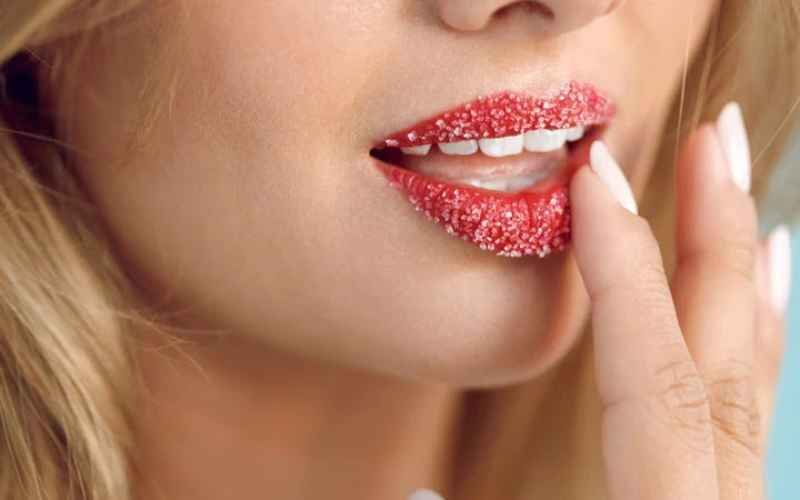Welcome to our lip-loving corner of the internet! Whether you’re a beauty enthusiast, skincare fanatic, or just someone who appreciates a good lip balm, you’ve come to the right place. In this comprehensive guide, we’re diving deep into the world of lip balms, exploring their benefits, ingredients to look out for, and even some DIY recipes for those feeling adventurous. So, grab your favorite lip balm and let’s embark on this journey to healthier, happier lips!

Chapter 1: The Importance of Lip Care
Our lips play a vital role in our daily lives, yet they’re often overlooked when it comes to skincare. Despite being a focal point of our facial features, they tend to be neglected in skincare routines. However, they deserve just as much attention and care as the rest of our face, if not more.
The reason for this special attention lies in the unique anatomy of our lips. Unlike the skin on the rest of our face, our lips lack oil glands. These glands are responsible for producing sebum, the natural oil that moisturizes and protects our skin. Without this natural protection, our lips are left vulnerable to dryness, chapping, and cracking, especially in harsh weather conditions like extreme cold or dry heat.
Enter the hero of lip care: lip balm. Lip balms are specifically formulated to provide the essential moisture, protection, and nourishment that our lips crave. By applying lip balm regularly, you can replenish lost moisture, create a barrier against external aggressors, and keep your lips soft, smooth, and oh-so-kissable.
But lip balm isn’t just a cosmetic luxury; it’s a fundamental aspect of lip care. Beyond simply enhancing the appearance of your lips, using lip balm helps maintain their health and integrity. Whether you’re facing the biting cold of winter or the scorching sun of summer, lip balm is your lips’ best defense against the elements.
In this chapter, we’ll delve deeper into why lip care is essential, exploring the unique needs of our lips and the benefits of incorporating lip balm into your daily skincare routine. So, let’s embark on a journey to discover the importance of giving your lips the love and care they deserve.
Chapter 2: Decoding Lip Balm Ingredients
Ever find yourself staring at the endless array of lip balms in the beauty aisle, feeling overwhelmed by all the options? Understanding the ingredients list can help you make informed choices and find the perfect lip balm for your needs.
When it comes to selecting the right lip balm, it’s essential to pay attention to the ingredients. Each component serves a specific purpose in nourishing and protecting your lips. From hydrating ingredients like beeswax and shea butter to soothing agents like vitamin E and aloe vera, the key components work together to make a lip balm truly effective.
Beeswax: One of the most common ingredients found in lip balms, beeswax forms a protective barrier on the lips, sealing in moisture and preventing dehydration. It also provides a smooth texture and helps the lip balm adhere to the lips for longer-lasting hydration.
Shea Butter: Known for its deeply moisturizing properties, shea butter is rich in vitamins and fatty acids that nourish and soften the lips. It helps restore the skin’s natural barrier, making it ideal for soothing dry and chapped lips.
Vitamin E: A powerful antioxidant, vitamin E helps protect the lips from environmental damage by neutralizing free radicals. It also promotes healing and regeneration, making it effective in repairing dry, cracked lips.
Aloe Vera: Renowned for its soothing and hydrating properties, aloe vera is a natural moisturizer that helps calm inflammation and irritation on the lips. It forms a protective layer over the skin, keeping it hydrated and supple.
Coconut Oil: With its emollient properties, coconut oil helps moisturize and soften the lips while providing a subtle shine. It’s easily absorbed into the skin, making it an excellent ingredient for restoring moisture balance.
Jojoba Oil: Similar to the skin’s natural oils, jojoba oil helps moisturize and protect the lips without clogging pores. It absorbs quickly and leaves the lips feeling soft and hydrated.
By understanding these key ingredients and their benefits, you can make informed choices when selecting a lip balm that suits your preferences and addresses your specific lip care needs. Whether you’re looking for intense hydration, soothing relief, or natural nourishment, decoding the ingredients list will help you find the perfect lip balm to keep your lips soft, smooth, and healthy.
Chapter 3: Finding Your Perfect Match
With so many lip balms on the market, how do you find “the one” that’s right for you? It all comes down to personal preference and your lips’ unique needs.
When searching for your perfect lip balm match, consider the following factors:
1. Texture: Lip balms come in various textures, from thick and creamy to lightweight and gel-like. Some prefer the richness of a balm, while others prefer a lighter feel. Experiment with different textures to find what feels most comfortable and nourishing on your lips.
2. Scent: Are you a fan of fruity, floral, or herbal scents? Some lip balms offer a subtle fragrance that adds to the sensory experience, while others are fragrance-free for those with sensitivities. Choose a scent that delights your senses and makes applying lip balm a pleasant ritual.
3. Flavor: Many lip balms come in delicious flavors like strawberry, vanilla, or coconut. If you enjoy a hint of flavor when you apply lip balm, explore the range of options available. Just make sure to opt for natural flavors or essential oils rather than artificial additives.
4. Finish: Do you prefer a glossy shine or a matte finish? Some lip balms leave a glossy sheen on the lips, while others provide a more natural or matte look. Consider your desired aesthetic when selecting a lip balm finish that complements your style.
5. Ingredients: Pay attention to the ingredients list and choose lip balms formulated with nourishing and moisturizing ingredients like shea butter, coconut oil, and vitamin E. Avoid products containing harsh chemicals or potential allergens, especially if you have sensitive skin.
6. Sun Protection: For added protection, opt for a lip balm with SPF to shield your lips from the sun’s harmful UV rays. Look for broad-spectrum SPF ingredients like zinc oxide or titanium dioxide to ensure comprehensive sun protection.
By exploring different textures, scents, finishes, and ingredients, you can discover your perfect lip balm match that not only meets your preferences but also addresses your lips’ unique needs. Whether you’re seeking intense hydration, subtle color, or sun protection, there’s a lip balm out there that’s perfect for you.
Chapter 4: DIY Lip Balm Recipes
Feeling crafty? Why not try your hand at making your own lip balm? Not only is it fun and rewarding, but it also allows you to control the ingredients and customize the formula to suit your preferences.
Making DIY lip balm is a creative and fulfilling endeavor that enables you to create personalized lip care products tailored to your needs. Whether you’re a beginner or an experienced crafter, there’s a lip balm recipe out there for you. From simple two-ingredient balms to luxurious botanical blends, we’ll share some easy DIY recipes that will leave your lips feeling pampered and nourished.
1. Basic Beeswax Lip Balm
- 1 tablespoon beeswax pellets
- 2 tablespoons coconut oil
- Optional: a few drops of essential oil for fragrance
Instructions:
- Melt the beeswax pellets and coconut oil together in a double boiler or microwave.
- Once melted, remove from heat and stir in any optional essential oils for fragrance.
- Carefully pour the mixture into lip balm containers or small jars.
- Allow the lip balm to cool and solidify before use.
2. Honey & Shea Butter Lip Balm
- 1 tablespoon shea butter
- 1 tablespoon coconut oil
- 1 teaspoon honey
- Optional: a few drops of vitamin E oil for added nourishment
Instructions:
- In a heat-safe container, melt the shea butter and coconut oil together.
- Stir in the honey until well combined.
- Optionally, add a few drops of vitamin E oil for extra nourishment.
- Pour the mixture into lip balm containers and allow it to cool and harden.
3. Lavender & Mint Lip Balm
- 2 tablespoons beeswax pellets
- 2 tablespoons coconut oil
- 5-10 drops lavender essential oil
- 5-10 drops peppermint essential oil
Instructions:
- Melt the beeswax pellets and coconut oil in a double boiler or microwave.
- Remove from heat and stir in the lavender and peppermint essential oils.
- Pour the mixture into lip balm containers and let it cool until solid.
These DIY lip balm recipes are just a starting point, and you can customize them with your favorite ingredients, scents, and flavors. Experiment with different oils, butters, and essential oils to create unique lip balms that cater to your preferences and skincare needs. Enjoy the process of crafting your own lip care products and indulge in the luxurious feeling of nourished, pampered lips!
Chapter 5: Tips for Healthy Lips
In addition to using lip balm regularly, there are several other habits you can incorporate into your routine to maintain soft, healthy lips.
1. Stay Hydrated
Drinking an adequate amount of water is essential for overall skin health, including the delicate skin of your lips. Aim to drink at least 8 glasses of water a day to keep your body and lips hydrated from the inside out.
2. Exfoliate Gently
Regular exfoliation helps remove dead skin cells and promotes cell turnover, keeping your lips soft and smooth. Use a gentle lip scrub or a soft toothbrush to exfoliate your lips once or twice a week, being careful not to overdo it and cause irritation.
3. Protect Your Lips from the Sun
Just like the rest of your skin, your lips can be damaged by the sun’s harmful UV rays. Apply a lip balm with SPF before heading outdoors, and reapply throughout the day, especially if you’ll be spending extended periods in the sun.
4. Avoid Licking or Biting Your Lips
While it may be tempting to lick or bite your lips when they feel dry, this habit can actually worsen dryness and lead to irritation. Instead, reach for your lip balm to provide instant moisture and relief.
5. Use a Humidifier
During the dry winter months or in environments with low humidity, using a humidifier can help add moisture to the air and prevent your lips from becoming dry and chapped.
6. Remove Lipstick Before Bed
Leaving lipstick or lip products on overnight can clog pores and lead to dryness and irritation. Make sure to remove all makeup from your lips before bed and apply a nourishing lip balm to keep them hydrated while you sleep.
Incorporating these simple tips into your daily routine will help keep your lips soft, smooth, and healthy. Remember, consistency is key, so make caring for your lips a priority to achieve the perfect pout all year round.
Conclusion:
And there you have it—your ultimate guide to lip balm! Whether you’re a lip balm connoisseur or a newcomer to the world of lip care, we hope this guide has been informative and inspiring.
Remember, healthy lips are happy lips, so don’t forget to show them some love with a nourishing lip balm each day. Whether you’re battling dryness, seeking sun protection, or simply indulging in a bit of self-care, your lips will thank you for the attention.
Top 20 FAQs about The Secrets of Lip Balm: Your Ultimate Guide to Soft, Supple Lips
- What is lip balm, and why is it important? Lip balm is a skincare product designed to moisturize and protect the lips. It’s important because our lips lack oil glands, making them susceptible to dryness and cracking, especially in harsh weather conditions.
- How often should I apply lip balm? It’s recommended to apply lip balm as needed throughout the day, especially in dry or windy conditions.
- Can lip balm expire? Yes, lip balm can expire. Check the expiration date on the packaging, and if it smells off or changes in texture, it’s time to replace it.
- Can I use lip balm on chapped skin other than my lips? Yes, you can use lip balm on other areas of chapped skin, such as dry cuticles or elbows.
- Are there different types of lip balms for different seasons? Some lip balms are formulated with ingredients to provide extra protection in harsh weather conditions, but ultimately, it depends on personal preference and your lips’ needs.
- Can I use lip balm under lipstick? Yes, applying lip balm before lipstick can help moisturize your lips and create a smoother base for application.
- What should I do if I have an allergic reaction to lip balm? Discontinue use immediately and consult a healthcare professional if you experience any allergic reactions to lip balm.
- Can I make my own lip balm at home? Yes, there are many DIY lip balm recipes available using natural ingredients like beeswax, coconut oil, and essential oils.
- Does lip balm protect against sunburn? Some lip balms contain SPF to protect against sunburn, but not all do. Look for lip balms with SPF for sun protection.
- Can I use lip balm on my children? Yes, there are lip balms formulated specifically for children, but always check the ingredients and consult with a pediatrician if you have concerns.
- What are some common ingredients in lip balm? Common ingredients in lip balm include beeswax, shea butter, coconut oil, vitamin E, and various essential oils.
- Can lip balm help with cold sores? While lip balm can help moisturize cold sores, it’s not a treatment for the underlying virus. Consult a healthcare professional for appropriate treatment options.
- Can I use lip balm overnight? Yes, using lip balm overnight can help hydrate and nourish your lips while you sleep.
- Can lip balm be used as a primer for lipstick? Yes, applying lip balm before lipstick can act as a primer and help the lipstick glide on more smoothly.
- How do I choose the right lip balm for my lips? Consider factors like your lips’ needs (hydration, sun protection), preferences (texture, scent), and any sensitivities or allergies you may have.
- Can lip balm cause dependency? While it’s possible to become reliant on lip balm, especially if you use it excessively, using it in moderation and addressing underlying causes of dryness can help prevent dependency.
- Can I use lip balm on sunburned lips? Yes, using a moisturizing lip balm can help soothe sunburned lips, but be gentle and avoid products with harsh ingredients.
- How do I store lip balm? Store lip balm in a cool, dry place away from direct sunlight and heat to prevent melting or changes in texture.
- Is it okay to share lip balm with others? It’s best to avoid sharing lip balm to prevent the spread of germs and bacteria. Use your own applicator or apply with clean hands.
- Can I use lip balm on top of lip filler injections? Consult with your healthcare provider for specific instructions, but generally, it’s safe to use lip balm after lip filler injections to keep your lips moisturized and comfortable during the healing process.



